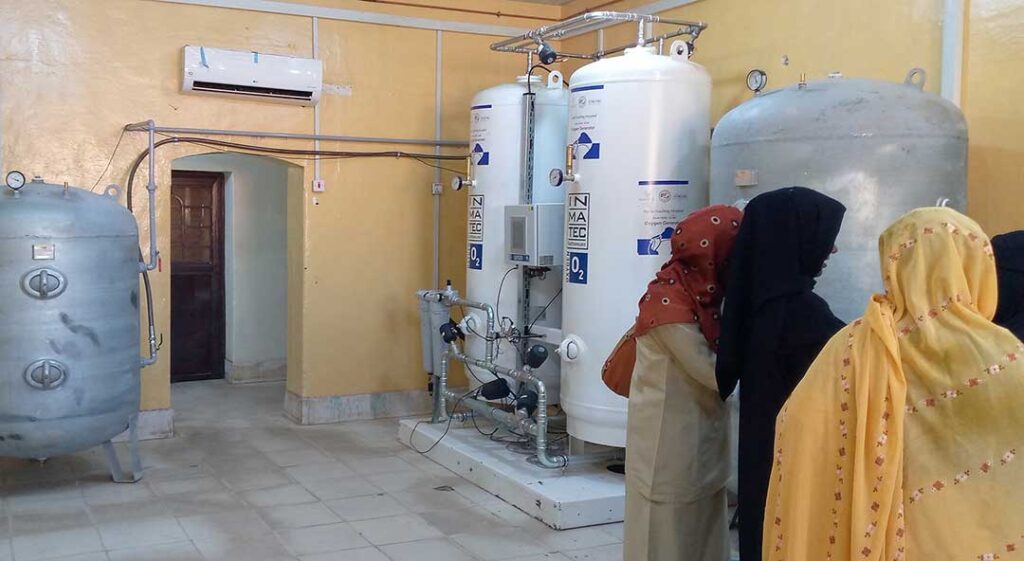ADF STAFFB
Her emotions swirling, Kawthar Muhammad Musaed spoke at the recent opening of a medical oxygen generation plant — the first of its kind in Sudan’s Darfur region.
Musaed recounted her search for medical oxygen in Nyala, the capital of South Darfur state. She was determined to help her mother, who suffered from heart disease.
“I took her to Al-Abrar Hospital,” she said during the inauguration ceremony at Nyala Teaching Hospital on December 20. “The doctor informed her that there was no oxygen, and we went to the teaching hospital. I did not find a bed for her. I did not find anyone to save her. She passed away.”
Despite her deep sadness, Musaed told a crowd of community members and reporters that she was happy to see the opening of the oxygen plant, because it will save many lives.
Thousands of kilometers away, Secretary General of the Sudanese American Physicians Association (SAPA) Dr. Mohamed Yahia Elsaid expressed satisfaction in seeing the result of his organization’s fundraising.
“This oxygen plant is the largest in Sudan outside Khartoum, the capital,” he told ADF. “It’s capable of supplying the oxygen needs for the whole South Darfur state and neighboring states. There is also an internal oxygen network connected throughout the hospital.
“We are very proud of this project, and we are looking forward to working on similar projects in the future.”
Stories like Musaed’s have transpired throughout Sudan. because oxygen has been in high demand and short supply sincethe third wave of the COVID-19 pandemic surged in April 2021.
Hussein Malasi, a senior manager at the Sudanese Liquid Gas Co., said in May that before COVID-19, the company could produce enough medical oxygen to meet the country’s needs. He also said a lack of cylinders further hindered the ability to transport oxygen.
“Before the severity of this pandemic, the distribution of cylinders across the hospitals was sufficient,” he told Reuters. “What’s happened is the consumption of oxygen has increased several times with the pandemic, while the cylinders at the hospitals did not increase at the same levels.”
Dr. Montasir Osman, deputy director of the General Department of Emergencies and Epidemics at the Ministry of Health, confirmed in April that the lack of oxygen resulted in the transfer of some patients, sometimes across states.
Sudan had 46,518 confirmed COVID-19 cases and 3,298 deaths, according to the Africa Centres for Disease Control and Prevention’s January 12, 2022, statistics. But officials have long acknowledged that the country’s low rate of testing means that the actual numbers likely are much higher.
A December 2020 report from the Imperial College London COVID-19 Response Team estimated that just 2% of all COVID-19 deaths are recorded in Sudan.
Early in December 2021, hospital managers in Khartoum warned of “an imminent collapse” in health care delivery because the country’s Health Ministry support had fallen sharply since the military coup on October 25.
On January 11, 2022, Dr. Mohamed El Tijani, director of the Khartoum Epidemiology Department, declared that a severe fourth wave had begun and warned of the limited capabilities of the country’s isolation centers.
He said confirmed cases in Khartoum doubled within a week — from 336 in the last week of December 2021 to 792 in the first week of January 2022.
With more than 5,000,000 people, South Darfur is the country’s second-most-populous state. Before the oxygen plant was built, the state relied on oxygen from Khartoum, more than 1,000 kilometers away.
Dr. Elyas Abakar, director-general of Nyala Teaching Hospital, said many lives were needlessly lost because state hospitals had a complete lack of medical oxygen at times.
At the opening ceremony of the oxygen plant, he thanked SAPA and humanitarian health organization MedGlobal for raising the $196,300 necessary for its construction.
“It’s a dream come true for the people of Darfur,” he said.

